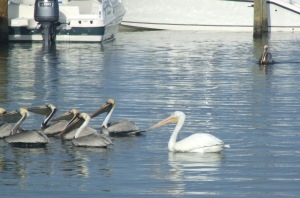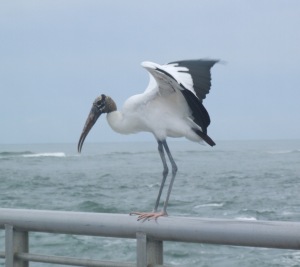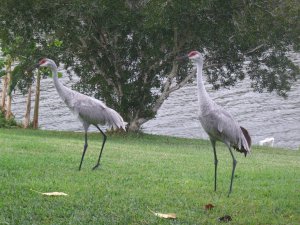Bland descriptions often suffice in real life. When the “nice house” or “good meal” or “pretty woman” is there, no specifics are required. The senses of the observer can take it all in. But storytellers can’t rely on general words and generic phrases.

Why say pelican when you can say “white pelican” and distinguish the bird from his brown brethren? https://www.audubon.org/field-guide/bird/american-white-pelican

A wood stork shares an Atlantic pier with other anglers, including the human variety. https://www.audubon.org/field-guide/bird/wood-stork

Serene Sandhill Cranes seem to enjoy hanging out in lakeside neighborhoods.
https://www.audubon.org/field-guide/bird/sandhill-crane
“She wore a dress,” one of my editing clients wrote. When I pressed for details, all he could come up with was “blue.” When I asked for more I got “long.”
“I don’t know anything about clothes styles,” he said.
That’s no excuse, I told him. That’s what the internet is for. Even if you’re writing a magical epic in which the clothing worn is like nothing ever before created, you can still draw inspiration from fashion photos and drawings. Type in “long blue dress” and go from there.
Another one of my clients who’s working on a romance trilogy used Google images to reveal what her big strong hunk of a hero looks like, plugging in the words she’d written about his physical appearance. Turns out he’s a younger version of her husband.
Another client, working on his hippie-roadie memoir, was telling us too little about his travels on the South and Central American section of the infamous Pan-Am Highway. What did the flowers look like? What kinds of trees? What colors were the “bright fabrics” in the market? What kind of shape was the road in? Can you really harvest magic mushrooms from cow patties and if so, do you do it with your hands? There are details he doesn’t easily remember. He’s not into electronic communication, so I’m doing the research with him, giving names to the “red flowers,” finding another word besides “lush” for describing tropical landscapes, describing the color of the dirt and the call of the red-winged blackbird (https://www.audubon.org/field-guide/bird/red-winged-blackbird).
I had such a blast on the Audubon Society Field Guide site that I return to it periodically, marveling at the diversity of birds and their voices. There’s a playlist of high-quality audio links for each species featuring its repertoire of calls, from mating to migrating. Here are some of my favorites, including the birds featured in this blog post:
https://www.audubon.org/field-guide/bird/white-ibis
https://www.audubon.org/field-guide/bird/american-white-pelican
https://www.audubon.org/field-guide/bird/wood-stork
https://www.audubon.org/field-guide/bird/snowy-egret
https://www.audubon.org/field-guide/bird/canada-goose
https://www.audubon.org/field-guide/bird/sandhill-crane
Next time you’re having difficulty conjuring in your mind’s eye the kind of trees in a Deep South forest or what the air smells like in a paper-mill town or how much snow is on the ground in Scotland in December, turn to the search engine of your choice. A few key words will yield a plethora of details to choose from. It’s a quick, fascinating way to infuse your writing with the vivid descriptions that compel readers to sink into your story.
What’s the coolest thing your ever researched for a story you were working on?


You have been a busy girl since seeing u last,hope all is well with u guys missed u again in fla,we are year round residents now and i love it,don t have to shovel the heat and it is better for my deteriating health (spellcheck) going to try and read some of your stuff now that i see it anyway keep in touch will give u both our emails love your pig tails!, candy is elvisfanmke@gmail
We’ll be in touch, so great to hear from you! Will be down next fall for sure beginning sailing around for my book tour – novel coming out in the fall, so excited. Also excited to get back on the boat.